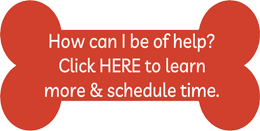So often I see people tell their dog GOOD sit after their dog sits, or GOOD whatever the behavior is that the dog is doing.
However, to help their (and your) dog to learn to do that behavior when asked, just saying GOOD or YES or CLICK and then following that with something your dog values gives better information to your pet to help that lesson succeed.
Keeping the target behavior in mind (I’ll use sit as my example), if you have or are teaching your dog to put his rear end on the ground after he hears SIT (or a hand motion), then you are teaching sit as a cue to do that specific behavior. In other words, you are teaching your dog this: that AFTER you hear the word SIT, if you put your rear end on the ground, THEN reinforcement happens. SIT is like a green light that, when it is green, gives the learner a set amount of time to do the behavior to earn reinforcement before the light turns red.
To learn that, your pet needs good clarity from you – the teacher. Teaching with clarity involves a number of things, among them includes both timing in delivery of the valued consequence (contiguity) and building the contingency or association between the behavior and the consequence (if you do this, then this happens).
The quicker the consequence occurs after a behavior, the quicker the student can learn that THAT specific behavior caused THAT specific outcome. This is one of the great benefits to using markers in training dogs. A marker is a sound or other signal that communicates to the animal that at that specific instant, he did exactly what you are looking for. To be effective, the marker should stand out from the environment (see my post on salience), should be followed by a reinforcer, and should occur immediately upon the wanted behavior.
While GOOD can work as a marker as it is short and precise (however, if it is a word you use frequently in everyday interactions – you may be better to find a more unique word so that it has more salience), can you see how adding the word SIT to it can muddy the training? Your dog is already doing the behavior that you are looking for. There is no need in that moment to re-cue your dog.
Remember, your dog does not speak the same language we do. Being as clear as you can with your lesson will not only help your dog learn but also help you to be a more effective teacher.








